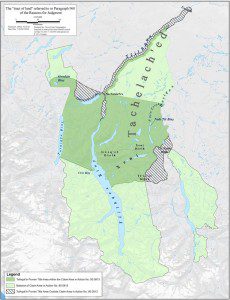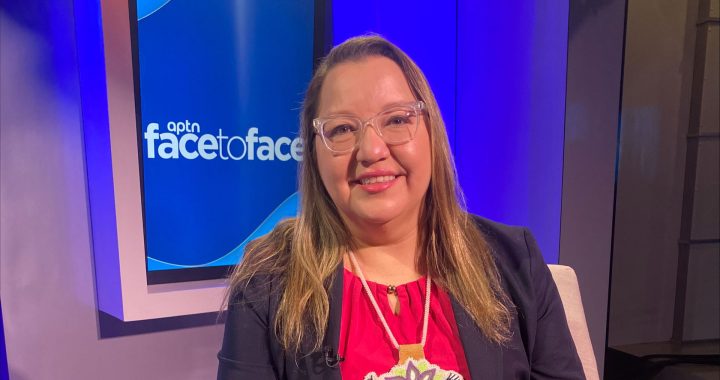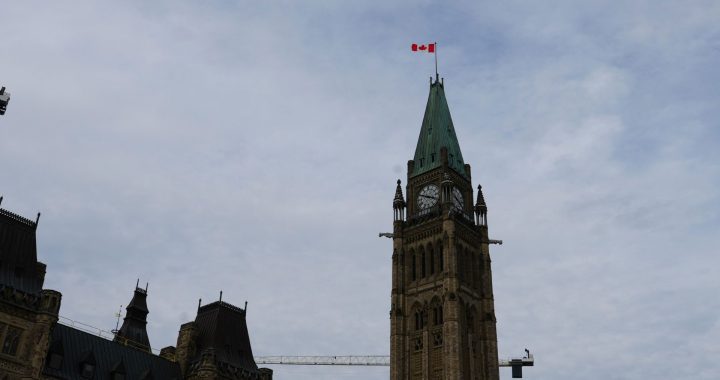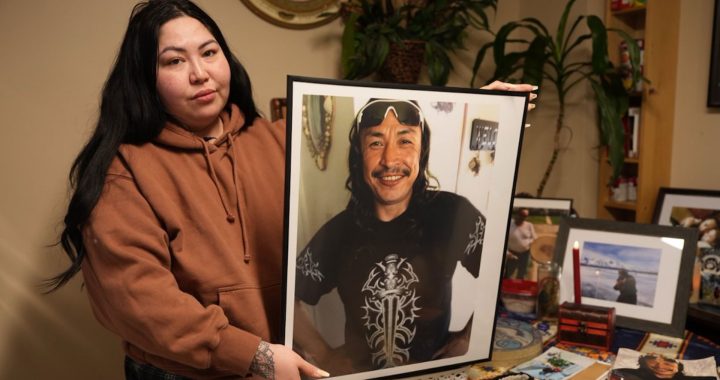APTN National News
OTTAWA–The Supreme Court of Canada has granted a declaration of Aboriginal title to the Tsilhqot’in over 1,750 square kilometres of territory in a historic ruling handed down Thursday.
This is the first time the high court has ever granted a declaration of Aboriginal title to a First Nation. The ruling also acknowledges Indigenous nations can claim occupancy and control over vast swaths of land beyond specific settlement sites, provides more clarity on Aboriginal title and sets out the parameters for government “incursion” into land under Aboriginal title.
The ruling also hands a final victory to the Tsilhqot’in Nation, which encompasses six communities with a population of about 3,000 people, over British Columbia in a long-running battle, which included blockades, over logging permits in their claimed territory.
“I would allow the appeal and grant a declaration of Aboriginal title over the area at issue, as requested by the Tsilhqot’in,” said the unanimous ruling, written by Chief Justice Beverley McLachlin. “I further declare that British Columbia breached its duty to consult owed to the Tsilhqot’in through its land use planning and forestry authorization.”
British Columbia and Ottawa both opposed the Tsilhqot’in claim to title.
The Supreme Court blasted the B.C. Court of Appeal, which had overturned a lower court ruling on what territory the Tsilhqot’in could claim under Aboriginal title. The high court found the Court of Appeal’s definition of occupancy too narrow.
“There is no suggestion in the jurisprudence or scholarship that Aboriginal title is confined to specific village sites or farms, as the court of appeal held,” said the ruling. “Rather, a culturally sensitive approach suggests that regular use of territories for hunting, fishing, trapping and foraging is ‘sufficient’ use to ground Aboriginal title.”
The high court said that Aboriginal title could be declared over territory “over which the group exercised effective control at the time of assertion of European sovereignty.”
Tsilhqot’in Nation Tribal Chair Joe Alphonse called the ruling “amazing” and said it marked the beginning of a “new Canada.”
Alphonse said the ruling also sent a message to Canada’s political leaders.
“It sends a strong message to all provincial leaders and Stephen Harper to deal with us in an honourable and respectful way,” he said.
“It’s a game-changer,” said Grand Chief Stewart Phillip, president of Union of BC Indian Chiefs.
Phillip said the ruling was met by “tears and cheers” from the Tsilhqot’in and other First Nations leaders gathered in a Vancouver boardroom awaiting the Supreme Court’s words.
B.C. Justice Minister Suzanne Anton said the decision provided “additional certainty around processes and tests that are applied to the relationship between the province and Aboriginal peoples.”
Anton said the province would “take the time required to fully analyze it and work with First Nations, industry and all of our stakeholders as we do so.”
Aboriginal Affairs Minister Bernard Valcourt said the government would be studying the “complex” ruling.
“Our government believes that the best way to resolve outstanding Aboriginal rights and title claims is through negotiated settlements that balance the interests of all Canadians,” said the statement.
NDP Aboriginal affairs critic Jean Crowder said her party welcomed the ruling.
“We finally have a decision that makes it clear that all levels of government must consult with and obtain consent from First Nations with Aboriginal title to their land, because they have the exclusive right to proactively use and manage land that they have title to,” said Crowder.
Liberal Aboriginal affairs critic Carolyn Bennett said the ruling provided much needed clarity.
“The Crown must commit to working in true partnership with Aboriginal communities, based on inherent and treaty rights to build a more prosperous future for all Canadians,” said Bennett.
‘We are completing this journey’
In the ruling, the Supreme Court laid markers for what established Aboriginal title means.
“Aboriginal title confers ownership rights similar to those associated with fee simple, including: the right to decide how the land will be used; the right to the economic benefits of the land; and the right to pro-actively use and manage the land,” said the ruling.
The ruling said Aboriginal title came with an important restriction, that “it is collective title held not only for the present generation, but for all succeeding generations.”
Land under Aboriginal title, “cannot be alienated except to the Crown or encumbered in ways that would prevent future generations of the group from using and enjoying it. Nor can the land be developed or misused in a way that would substantially deprive future generations of the benefit of the land.”
As a result of the ruling, governments now must meet a set-out standard for “incursions” into land under established Aboriginal title.
“Government incursions not consented to by the title-holding group must be undertaken in accordance with the Crown’s procedural duty to consult,” said the ruling. “And must also be justified on the basis of a compelling and substantial public interest and must be consistent with the Crown’s fiduciary duty to the Aboriginal group.”
The Supreme Court found that British Columbia breached its fiduciary duty to consult with the Tsilhqot’in and that it had no economic justification for issuing logging permits in the claimed territory, which sparked the over two-decade battle. The province was argued that it stood to benefit economically from logging in the claimed area and also that it needed to stop the spread of a mountain pine beetle infestation.
“Granting rights to third parties to harvest timber on Tsilhqot’in land is a serious infringement that will not lightly be justified,” said the ruling. “Should the government wish to grant such harvesting rights in the future, it will be required to establish that a compelling and substantial objective is furthered by such harvesting, something that was not present in this case.”
The legal battle began in December 1989 with a filing by Xeni Gwet’in, but it had simmered since 1983 when the province granted Carrier Lumber Lt. a forest license to log in the community’s claimed territory.
The Tsilhqot’in launched blockades, forcing the province to begin talks which went nowhere after the Xeni Gwet’in claim to a right of first refusal to logging. The long running legal filing was amended in 1998 to include the whole Tsilhqot’in Nation.
The trial finally began in 2002 and ran for 339 days. The trial judge Justice David Vickers travelled to the claim area, heard from elders, historians and experts while also reviewing historical texts, including the diaries of Alexander Mackenzie and Simon Fraser.
Vickers found that the Tsilhqot’in were entitled to a declaration of Aboriginal title to about 40 per cent of their total claimed territory. Vickers did not make a declaration of title on procedural grounds.
The B.C. Court of Appeal then faced the case and held that the Tsilhqot’in had not established title and found the nation could only claim territory were evidence existed of extensive use and occupancy. The Supreme Court eviscerated that position in Thursday’s ruling.
“We take this time to join hands and celebrate a new relationship with Canada. We are reminded of our elders who are no longer with us. First and foremost we need to say sechanalyagh (thank you) to our Tsilhqot’in Elders, many of whom testified courageously in the courts, said Xeni Gwet’in Chief Roger William, whose name was used in the original filing. “We are completing this journey for them and our youth. Our strength comes from those who surround us, those who celebrate with us, those who drum with us.”
During a press conference in Vancouver, some of the Tsilhqot’in leaders referred to the 1864 Chilcotin War that ended in the death of at least 19 European settlers and the hanging of six Tsilhqot’in chiefs.
Back then they faced a planned toll wagon road aimed at connecting the nascent colony’s Pacific coast through Bute Inlet to the newly discovered gold fields of Williams Creek, in the B.C. interior.
The project threatened to upend the already besieged Tsilhqot’in people facing their first major outbreak of smallpox, spread in large part by infected blankets sold by traders.
“These white people, they bring blankets from people who die of smallpox,” said former Tsilhqot’in chief Henry Solomon, in an oral account of the small pox outbreak contained in a book called Nemiah: The unconquered country, by Terry Glavine.
“Then he wrap them up and he sell them to these Indians, then the Indian, he didn’t know, he just sleep on it, them blankets. Pretty soon he got them sickness, and pretty soon the whole camp got it. So pretty soon my grandmother and his sister, they’re the only one that survive.”
The road work began to cause friction with the Tsilhqot’in, even though some found jobs with the work crews.
There were incidents of road workers raping Tsilhqot’in girls. The Tsilhqot’in who worked with the crews were mistreated and denied food.
Then, in the spring of 1864, four bags of flour were stolen from a road crew’s base camp. The crew’s foreman threatened the Tsilhqot’in with smallpox for stealing.
Journalist Melvin Rothenburger, who wrote a book called the The Chilcotin War, believes this threat may have helped spark the war.
“That could have been an important factor because of the fear of smallpox and it had been rampant,” said Rothenburger, whose great-great grandfather Donald McLean was killed in the ensuing battles with the Tsilhqot’in.
News of the smallpox threat and rapes stirred a group of Tsilhqot’in to launch what turned into a guerilla war against the settlers. Of this group, a war chief known as Klatsassin or Lhatasassine, meaning “We do not know his name,” came to embody the Chilcotin War.
They fired their first shot on the morning of April 28, 1864. It killed a ferryman who refused Klatsassin and his party passage.
The next morning, at daybreak, Klatsassin and his war party descended on the main work crew camp. The cook, tending the fire, was the first to be cut down by gunfire. The Tsilhqot’in then severed the ropes of the tents, shooting and stabbing nine of the crew members to death.
Three managed to escape.
The war party then moved to another camp. There, the foreman who issued the smallpox threat was killed along with three other men.
The Tsilhqot’in used their knowledge of the rugged terrain to their advantage, setting traps, launching ambushes and eluding colonial parties for weeks that had been sent into the bush to track them down.
Rothenburger’s greath-great grandfather McLean met his death after falling into a trap set by the Tsilhqot’in. McLean followed a trail of wood shavings carved by the Tsilhoqot’in that led to an ambush. McLean, known to the Tsilhqot’in as Samandlin, wore a breast plate for protection, said Rothenburger.
“The Tsilhqot’in knew about this and set it up so they could get behind him,” said Rothenburger.
With the colony ramping up efforts against the guerillas, the Tsilhqot’in sought to negotiate peace. Believing they had been granted immunity, Klatsassin and a group of chiefs travelled to meet with Frederick Seymour, then the governor of the colony of British Columbia.
They were shackled in their sleep and taken prisoner. Klatsassin and four others were convicted of murder. They were hung at 7 a.m. in what is now Quesnel, B.C., on Oct. 26, 1864.
Before he died Klatsassin famously said, “We meant war, not murder.”
Two other Tsilhqot’in men also turned themselves in, offering to pay compensation for what they did. They were also arrested and sentenced to death. One managed to escape, but the other man named Ahan, was hung in New Westminster on July 18, 1865.
To this day, the Tsilhqot’in are still trying to recover his remains.
The provincial government apologized for the hangings in 1999.
-with APTN Files
@APTNNews












The pipeline will not go through, when Obama stop’s in with world and environmentalist support, who are the majority, and this will make him the greatest president of ecological and human preservation ever made by any president in the history to the United States of America! He as a Black President of the people of color of the U.S. could become a real First Nation Sun! And if he don’t, then, who is pulling his strings! like a uncle tom! But, I betting he is know uncle tom, completely, his decolonizing like we all must and institutions and authentic family centered, loving, compassionate and free democratic societies of earth, that’s, if our children our going to have a future with a living earth that sustains all life forces existence, that cares for those, that can’t care for themselves in a non violent existence!
We first nations leaders of North and South America will run Harper and his family right out of Canada and anyone with his neo-fascist politics’s of domination of life and of genocide of first nations peoples, cultures, lands, sovereignty, resources or any peoples of that matter! In the end Harper and his vain end, will leave Canada, forever!
🙂 hope it slows down the pipeline!!
Good luck with getting Harper to deal “…in an honourable and respectful way,”